Venice Miniature Railway
| Venice Miniature Railway | |
|---|---|
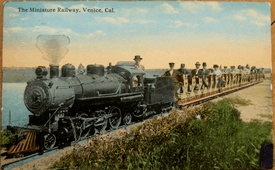 Steam loco No 2 of the Venice Miniature Railway
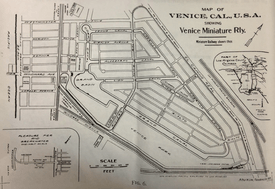 | |
| Technical | |
| Line length | 7,500 feet (2,300 m) |
| Track gauge | 18 in (457 mm) |
| Maximum incline | Lion Canal Bridge: 11 % |
The Venice Miniature Railway was a 42,069-foot (12,823 m) long miniature railway in the 1:3 scale with a gauge of 18 in (457 mm), which was in operation from 30 July 1905 to 13 February 1925 in Venice near Los Angeles in California.[2]
Location
Trips on the loop track started at the locomotive shed at the corner of Lake Avenue and El Camino Real (now Venice Boulevard and Abbot Kinney Boulevard) in a clockwise direction along Mildred Avenue towards the Business District. There the trains looped around the Post Office and again followed Mildred Avenue, until they crossed several canals on Riviera and Rialto. Finally, they turned sharply onto Washington Boulevard. They used El Camino Real to get back to the Lake Avenue Station and the locomotive shed.[3]
Cost
The cost of a trip around Venice was five cents. Regular users could buy a book of tickets for $1.00, which reduced the cost to only two cents per trip. At the same time, a one-way ride from Los Angeles to Venice on the Los Angeles Pacific Railway cost 15 cents.[4]
History
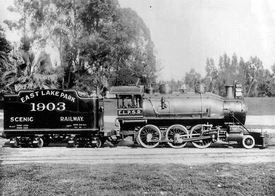
Abbot Kinney, who had come-up with the plans for Venice of America, contracted John J. Coit to build a miniature railway in Venice Beach near Los Angeles. Coit had worked as a master machinist at the Johnson Machine Works and had already built and operated the Eastlake Park Scenic Railway with a gauge of 18 in (457 mm) in Eastlake Park (now Lincoln Park).[3]
John J. Coit owned the oil-fired steam locomotive No. 1903 of the 2-6-0 type with an overall length above the couplings of 19 feet (5.8 m). This locomotive made use of some technical innovations such as controlling the valves without an eccentric, which made it easier to adjust and maintain the valves. It had been successfully used on the Eastlake Park Scenic Railway, but it was with 8,000 lb (3,629 kg) a bit too light and not powerful enough for the planned activity at Venice. Therefore, Coit ordered a 9,260 lb (4,200 kg) oilfired steam locomotive of the 2-6-2 (“Prairie”) type at his former employer, the Johnson Machine Works, into which his innovations had to be integrated.[3]
_and_No1_(behind).png)
The new, nearly identical steam locomotives No 1 and No 2 were called 1-Spot and 2-Spot. After Coit had issued the engineering drawings, he contracted the Johnson Machine Works for the manufacture. The boilers were made and supplied by the Pacific Coast Boiler Works in Los Angeles and were fit for a pressure of 175 psi (12 bar). The locomotives had a Walschaerts valve gear and cost $4,510 each. They were painted in black with polished brass bands and silver lettering. The only difference between them was the shape of the windows of their cabs: 1-Spot had rectangular windows with rounded corners at the top and the upper part of 2-Spot's windows was crescent-shaped. The maximum speed was 30 mph (48 km/h).[3]
The railway used ten passenger coaches in an elaborate Venetian style with lion’s head ornaments on their sides, which had been supplied by the J.G. McLain Company for $400 each. Five of them were painted in royal blue while the reminder were painted in cherry red. Each of them had twelve seats, and they were typically assembled to unicoloured trains.[3]
Disagreements
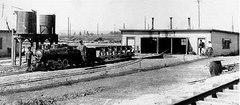
After a good start there was an increasing animosity between Kinney and Coit. Kinney insisted on his two very young sons being involved in the rail road. The eight-year-old Carleton was nominated as VMR President and the twelve-year-old Innes as Chief Engineer, which dishonored Coit's actual position. When Kinney wanted to get more control over the day-to-day business in Venice, he tried in 1906 to take over the railway from Coit, although they had both signed a five-year contract. He forced the railway to close down for six months during the summer, allegedly because one of the wooden bridges needed to be replaced by a concrete structure.[3]
In November 1906 Kinney tried to take over the railway while Coit was out of town. On Coit’s return, Coit removed some armatures and other essential parts from the locomotives before Coit went away on another trip. Because Kinney could not get these parts machined without drawings, he could not operate the railway for the reminder of that year. He sued Coit, and it came to a court case on November 20, 1906 at the Los Angeles County Court. Coit and his colleagues were deemed not guilty regarding the claims of vandalism and theft, but Kinney started civil proceedings against Coit, in which Kinney convinced an artitrator to make a decision in his favour on January 19, 1907. Thus Coit had to reinstall the missing parts and reimburse the cost. Subsequently, the railway was recommissioned. Coit left the company and did not get reinvolved with its business. It was regularly used for another 18 years until the early 1920s, when it lost its attraction due to increasing auto traffic. It was even seen as a nuisance by locals and visitors.[3]
Movies
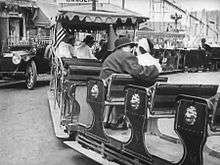
In Harold Lloyd's 1917 movie By the Sad Sea Waves his character pretends to be a beach lifeguard in order to be more attractive to the ladies. The movie concludes when Harold and his newest conquest Bebe Daniels ride off into the sunset aboard the Venice Miniature Railway. In his movie Number, Please? of 1920 he is less lucky, as he loses the girl, and rides off on the train all by himself.[5]
The Century Comedy Kids run the train on behalf of their sick father in the silent movie Speed Boys, which was released in Holland as The New Engine Driver and is available on YouTube.[6]
 Harold Lloyd: 'Number please?' (Screen shot)
Harold Lloyd: 'Number please?' (Screen shot) The Century Comedy Kids in 'Speed Boys' or 'The New Engine Driver'
The Century Comedy Kids in 'Speed Boys' or 'The New Engine Driver'
Closure
.jpg)
When Kinney died in November 1920, his adopted son Thornton Parillo continued to operate the railway. It was taken out of service on February 23, 1925, when an order had been issued which prohibited its further use.[3]
The 1-Spot was acquired from a scrap heap in Vernon by Al Smith (not the Orchard Supply Hardware executive who supported the Billy Jones Wildcat Railroad and Swanton Pacific). He reconditioned it and used it well into the 1950s in San Gabriel and Pico Rivera. After his death it was sold to Don McCoy who overhauled it together with his sons and used it from 1972 to 1978 at the Whittier Narrows Recreational Area. Since the closure of this railway, it is kept in the private collection of the McCoy family in southern California.[3]
The 2-Spot was coincidentally found and rescued at the last hour before its planned export to be scrapped in Japan by Billy Jones, who purchased it, reconditioned it, and used it on Sundays to entertain the neighbors’ children on his ranch. It is now regularly used at the Billy Jones Wildcat Railroad in Los Gatos, California.
Photographs
 John J. Coit engineers the No. 2 over a canal bridge
John J. Coit engineers the No. 2 over a canal bridge John J. Coit stands left of loco No. 2
John J. Coit stands left of loco No. 2 "Miniature Railway crossing bridge over Lagoon at Venice, Cal."
"Miniature Railway crossing bridge over Lagoon at Venice, Cal." The Miniature Railway at Midway Plaisance in Venice
The Miniature Railway at Midway Plaisance in Venice "Windward Avenue and Miniature Railway, Venice, California"
"Windward Avenue and Miniature Railway, Venice, California" Loco No 2 at the Windward Avenue Loop around the Post Office
Loco No 2 at the Windward Avenue Loop around the Post Office
See also
References
- ↑ Arthur W. Line: Venice Miniature Railway, The Model Engineer and Electrician, Mai 1909.
- ↑ Stanton, Jeffrey (April 6, 1998). "Venice Miniature Railroad".
- 1 2 3 4 5 6 7 8 9 Peter Panacy: Venice Miniature Railway. A Brief History and Its Influence on the Billy Jones Wildcat Railroad.
- ↑ Water and Power Associates: Early Southern California Amusement Parks.
- ↑ John Bengtson: Chaplin-Keaton-Lloyd film locations: Harold Lloyd – By the Sad, Santa Monica Waves.
- ↑ The Century Comedy Kids: 'The new engine driver' - 'Speed boys' (YouTube video with Dutch and English subtitles).
- ↑ Arthur W. Line: Model Railways – XIX. – Eastlake Park Scenic Railway, Los Angeles, California. The Model Engineer and Electrician, 23 April 1908. Pages 395, 396, 397, 398 and 399.
Coordinates: 33°59′21″N 118°27′47″W / 33.989077°N 118.463186°W